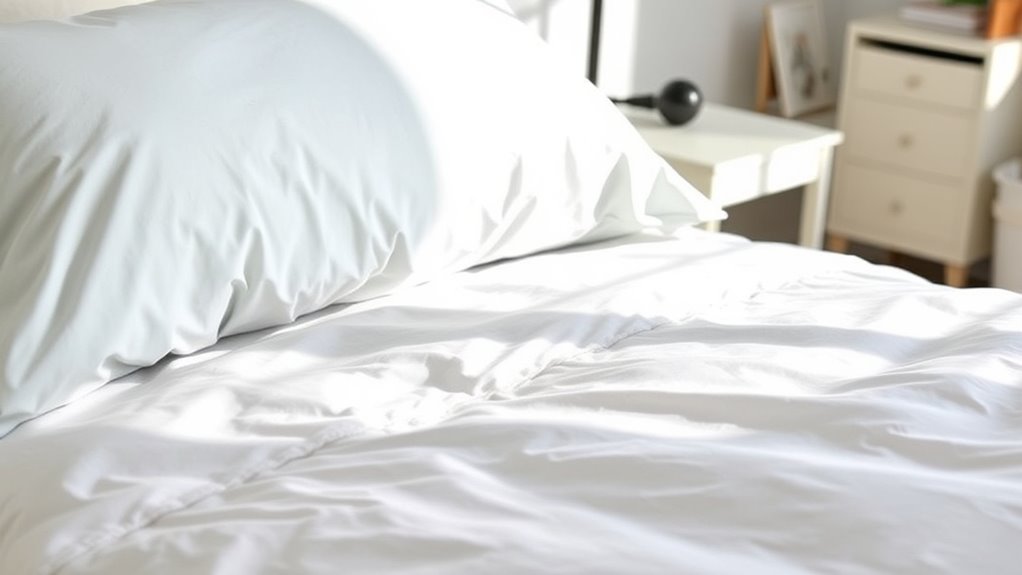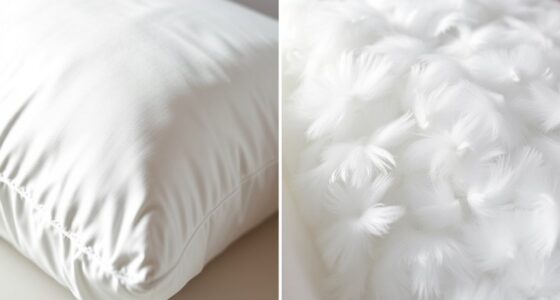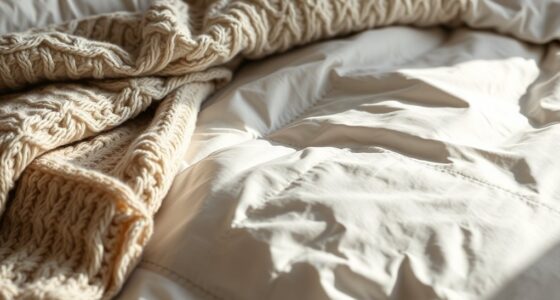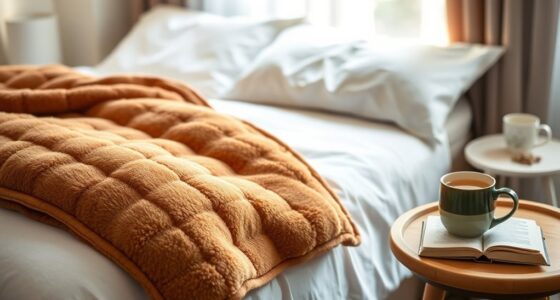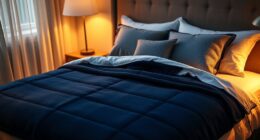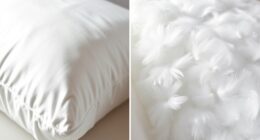To choose bedding for allergies, look for hypoallergenic materials like tightly woven cotton, silk, or specialized synthetics that block dust mites and mold. Wash sheets, pillowcases, and duvet covers weekly in hot water and use fragrance-free detergents. Add allergen-proof covers to pillows, mattresses, and comforters, and keep your sleeping area clean with regular vacuuming and low humidity. Staying consistent with these practices can markedly reduce allergy symptoms; discover more tips as you explore further.
Key Takeaways
- Select bedding made from hypoallergenic materials like tightly woven cotton, silk, or specialized synthetics to reduce allergen accumulation.
- Use allergen-proof covers for pillows, mattresses, and comforters to create a barrier against dust mites and allergens.
- Wash bedding weekly in hot water (~130°F or 54°C) with hypoallergenic detergents to eliminate dust mites and irritants.
- Maintain a clean sleeping environment by vacuuming with a HEPA filter and reducing clutter to minimize airborne allergens.
- Keep indoor humidity between 40-50% to inhibit mold growth and dust mite proliferation, supporting allergy relief.

If you suffer from allergies, selecting the right bedding can substantially reduce your symptoms and improve your sleep quality. The key is choosing bedding made from hypoallergenic materials that resist dust mites, mold, and other common allergens. Materials like tightly woven cotton, silk, or specialized synthetic fibers are less likely to trap allergens than traditional options. When shopping, look for products labeled as hypoallergenic, which indicates they’ve been designed or processed to minimize allergen presence. These materials create a barrier that keeps allergens out of your breathing zone, helping you breathe easier at night.
Beyond choosing the right materials, establishing a consistent washing routine is essential to maintaining allergy-friendly bedding. Regularly washing your sheets, pillowcases, and duvet covers at least once a week in hot water—around 130°F or 54°C—can eliminate dust mites and other irritants. Using hypoallergenic laundry detergents further reduces the risk of allergic reactions, as they’re formulated without harsh chemicals or fragrances that can aggravate sensitivities. Drying your bedding thoroughly, preferably in a hot dryer, ensures no moisture remains that could promote mold or dust mite growth. If you prefer air drying, make sure your bedding is completely dry before making your bed to prevent mold development.
Wash bedding weekly in hot water to eliminate dust mites and allergens, and dry thoroughly to prevent mold growth.
Implementing vacuuming with a HEPA filter regularly and maintaining a clean sleeping environment can greatly reduce airborne allergens. Investing in allergen-proof covers for pillows, mattresses, and comforters also makes a big difference. These covers act as a physical barrier, preventing allergens from settling into the bedding and making cleaning easier. When selecting these covers, ensure they are breathable and fit snugly to avoid gaps that allergens can slip through. Keep in mind that even the best hypoallergenic materials need regular maintenance; otherwise, dust and other particles can accumulate over time, defeating their purpose.
Creating a clean sleeping environment is just as important. Keep pets out of your bedroom, vacuum regularly with a HEPA filter, and reduce clutter that can harbor dust. Maintaining low humidity levels, around 40-50%, can also help prevent mold growth and dust mite proliferation. Remember, consistency is vital—adopting good washing routines and choosing the right hypoallergenic materials make your bedding less hospitable to allergens, directly impacting your comfort and health. By prioritizing these aspects, you’ll create a sleep space that reduces allergy symptoms and helps you wake up feeling refreshed and rested.
Frequently Asked Questions
Are Hypoallergenic Bedding Options Suitable for All Allergy Types?
Hypoallergenic bedding options are generally suitable for many allergy types, but not all. They often use hypoallergenic materials that help reduce triggers, and proper bedding maintenance, like regular washing, keeps allergens at bay. However, some allergies, such as certain chemical sensitivities, may require specific materials or treatments. It’s best to identify your allergy triggers and select bedding that minimizes exposure, ensuring both comfort and allergy relief.
How Often Should Allergy-Proof Bedding Be Replaced or Washed?
You should wash allergy-proof bedding at least once a week to reduce allergens like dust mites and pet dander. For replacement, follow the recommended timeline, typically every 2 to 5 years, depending on usage and wear. Regular washing and timely replacement help maintain a cleaner sleep environment, minimizing allergy symptoms. Always check manufacturer guidelines to guarantee your bedding stays effective and safe for allergy sufferers.
Can Natural Fibers Like Cotton or Silk Reduce Allergy Symptoms?
You might think natural fibers like cotton or silk are just luxurious, but they can dramatically reduce allergy triggers. These materials are breathable, allergen-resistant, and often come with bedding certifications that guarantee fewer irritants. Unlike synthetic fabrics, they offer superior bedding durability and allergy reduction, making your sleep environment healthier. Switching to natural fibers could be the game-changer you need to beat allergies and enjoy truly restful nights.
What Are the Signs That Bedding Is Triggering Allergy Symptoms?
If your allergy symptoms worsen after sleeping, you might notice dust mite indicators like increased sneezing, congestion, or itchy eyes. Skin irritation signs, such as rashes or eczema flare-ups, can also point to bedding as a trigger. Pay attention to these clues, and consider washing your bedding regularly or switching to hypoallergenic options to reduce exposure and improve your sleep quality.
Are There Specific Certifications to Look for in Allergy-Friendly Bedding?
When shopping for allergy-friendly bedding, look for certifications that meet strict standards, ensuring your bedding minimizes allergens. Certification standards like OEKO-TEX, GOTS, and CertiPUR-US verify that products are free from harmful chemicals and allergens. Always check allergy labels for clear indications of hypoallergenic qualities. These certifications and labels serve as the gold standard, giving you confidence that your bedding is designed to reduce allergy triggers and promote better sleep.
Conclusion
Think of your bedding as a fortress guarding against allergy invaders. With the right choices—hypoallergenic covers, easy-to-wash fabrics, and regular cleaning—you build a strong barrier that keeps allergens out. Just like a vigilant guardian, your bedding works tirelessly to protect your sleep sanctuary. So, arm yourself wisely and craft a cozy, allergen-free battlefield, ensuring peaceful, uninterrupted nights. Your health and comfort depend on the fortress you create—choose wisely and sleep soundly.
